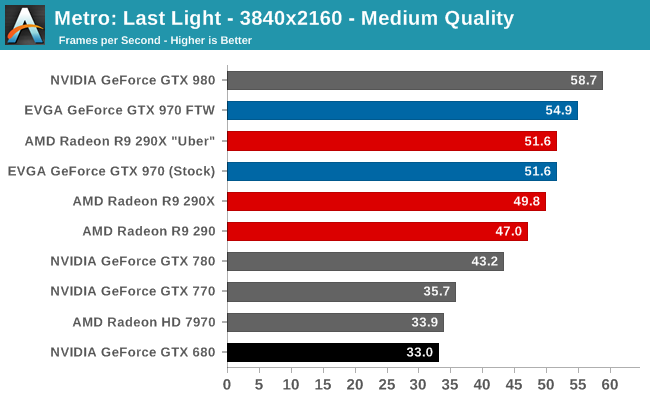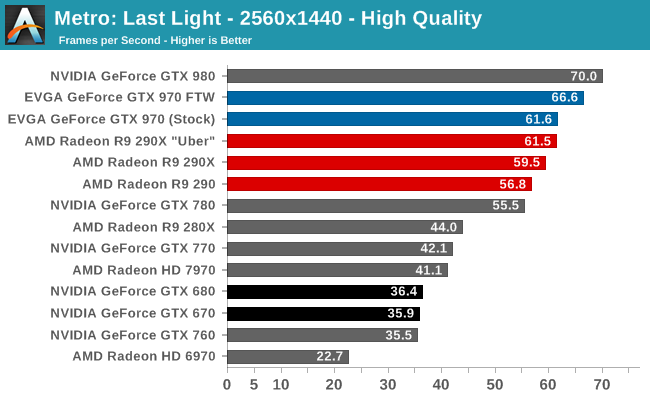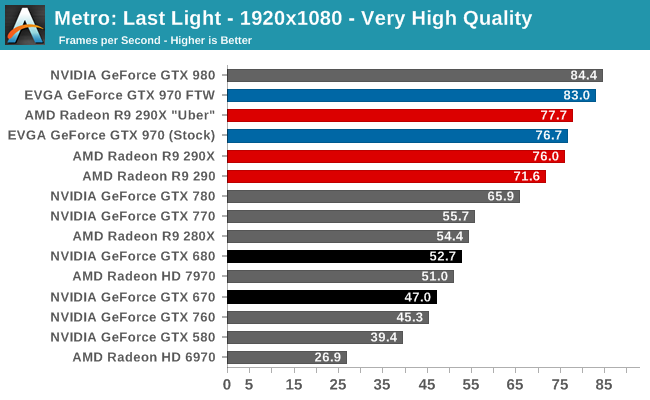The NVIDIA GeForce GTX 970 Review: Featuring EVGA
by Ryan Smith on September 26, 2014 10:00 AM ESTMetro: Last Light
As always, kicking off our look at performance is 4A Games’ latest entry in their Metro series of subterranean shooters, Metro: Last Light. The original Metro: 2033 was a graphically punishing game for its time and Metro: Last Light is in its own right too. On the other hand it scales well with resolution and quality settings, so it’s still playable on lower end hardware.



It seems fitting that we start with a game where the GTX 970 and R9 290XU start out tied. Even at the R9 290XU’s strongest hand – 4K – the GTX 970 is at parity and that remains for 1440p as well. Only at 1080p does the GTX 970 even begin to trail the R9 290XU.
This game ends up being a very good summary of what we’re going to see. The GTX 970 and R9 290XU trade blows from game-to-game, but in the end the two are a tie, just as we see here. Which for NVIDIA is a great outcome, as it means they’re tying a card that's nearly 50% more expensive.
Meanwhile if we push on the gas pedal a bit harder with the GTX 970 FTW, we see the EVGA card pull ahead of the R9 290XU and stock GTX 970 by 8%. This is a bit above average overall for the GTX 970 FTW, but it does conveniently highlight the fact that even if AMD officially pushed the clock speeds of R9 290XU a bit more, they’d still end up with GTX 970 right next to them.










155 Comments
View All Comments
vred - Friday, September 26, 2014 - link
Memory chips don't really need heatsinks, but memory VRMs do - so if overclocking memory, you have to watch their temperature and take care of their proper cooling.eanazag - Friday, September 26, 2014 - link
I am happy to see both Nvidia cards come out packing heat. for once Nvidia isn't totally price gouging at launch. In fact, we should see AMD prices come down soon as AMD reviews Nvidia's sales numbers. The 290 and 290X are pushing like 10 months on the clock at pretty much launch prices. it is about time we the price have a reason to come down. The 970 is the card to do so.Assumedly, Nvidia already has the 980 TI taped out for AMDs next response card. I am disappointed to see that there is no builtin audio decoder like in AMD. It means little hope to see many developers leveraging audio hardware to reduce CPU load in games with 5.1+ situations.
JlHADJOE - Saturday, September 27, 2014 - link
I doubt we'll see a 980Ti. Like the 680 before it, the 980 is already a fully enabled chip.Kraelic - Saturday, September 27, 2014 - link
It is a GM204 upper-midrange chip as were any Gxx04 chips before... this is like the launch of the 680 and 670 GK104 cards, then in the refresh 770 and 760 used those same chips when the 780 GK110 high end came out with the true flagship core.There will be a GM210 flagship taking the titan and x80 name, and the GM204 will go into the x70 and x60 cards at a lower price and this refresh is what I am interested in.
randomhkkid - Saturday, September 27, 2014 - link
However like the 780 before it is is also a Gxx04 chip so therefore there will be a Gxx10 chip above it suited to cards like the 980ti as was the case with the 780ti.randomhkkid - Saturday, September 27, 2014 - link
beaten to it ;)Samus - Sunday, September 28, 2014 - link
we'll probably see a 980Ti in the form of a 20nm part. even if there is no architectural difference they could tweak it for a smaller process while possibly boosting the clock. who knows...1500MHz GPU & 8GHz GDDR5?squngy - Thursday, November 20, 2014 - link
I'm not up to date, but if crypto-currency miners are still interested in radeon cards AMD might not rush to lower the price, or if they do the retailers will just pocket the difference and sell at the same price.AnnonymousCoward - Saturday, September 27, 2014 - link
A 10% OC won't heat a chip to the point of damage. You will most likely first reach the point when the memory fails to function.Btw Ryan, you keep saying it's "clocked at 7GHz" but I don't think that's true. Probably need to add the word "effective". Is the real clock 1/2 or 1/4 that?
MrSpadge - Saturday, September 27, 2014 - link
You'll frequently see 1/4 in OC tools. In the end it doesn't matter, both numbers are valid: one is the frequency of the data on the bus (the high marketing number) and the other one is the frequency of the memory chips.